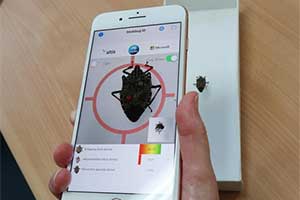On 21 October, the PBRI held its sixth forum for 2021 on Detection and Diagnostics, as part of a series of priority research topics which support plant biosecurity in Australia. The research forums are the first stage of a concept development process used by the PBRI members and partners for collaboration and co-investment. New plant biosecurity RD&E project ideas are initiated by these forums which are aligned to the PBRI Strategy.
Presentations from Australian and New Zealand research agencies, on the latest detection and diagnostic technology used to support plant biosecurity, were included in the program.
The chair of the Sub Committee for Plant Health Diagnostics (SPHD), Dr Brendan Rodoni (Ag Victoria Research), outlined the role of SPHD, a committee of state and territory diagnosticians, aiming to deliver and continual improve national plant health diagnostics. SPHD members have several working groups including a new group focused on developing standards for a High Throughout Sequencing (HTS) platform.
David Nehl, Director – Plant Pathology and Botany Section, Operational Science and Surveillance (DAWE) discussed the various pros and cons of using MALDI-TOF Mass Spectrometry for Biosecurity Diagnostics for border intervention, surveillance, regulated and natural pathways and vector monitoring.
Dr Kayvan Etebari, Research Fellow, School of Biological Science (UQ) presented his research on mitochondrial haplotyping for management of the Coconut Rhinoceros Beetle (CRB), supported by ACIAR. The range expansion of this pest in the Pacific Islands is related to a haplotype that is reported to show reduced susceptibility to the virus used to control the insect.
K’trie Coster, Project Manager, Rural R&D for Profit – Boosting Diagnostics (GRDC) presented the highlights of the $15 million, collaborative diagnostic project. The project’s key outputs will include 12 National Diagnostic Protocols, six early detection tools and five pest reference collections will be updated. This project also addresses gaps in national proficiency testing and industry training though incursion scenarios and diagnostic ‘blitzes’ on-farm.
Dr Monica Kehoe, Molecular Plant Pathologist (DPIRD, WA) expanded on the application of High Throughput Sequencing (HTS) as a national biosecurity tool, including agreed guidelines for reporting of data and outcomes. The sharing and coordination of HTS data for biosecurity within Australia is critical to the platform. Monica is part of a working group developing a strategic roadmap for the development and adoption of HTS as a diagnostic tool across all Australian jurisdictions.
Kathleen DeBoer, Project Officer (PHA) provided an update on the development of National Diagnostic Protocols (NDPs), the nationally agreed methods for use in emergency responses. PHA now have primary responsibility for the NDPs as well as the Australian Plant Pest Database (APPD). The APPD is being rebuilt, collating information on vouchered specimens from 16 major plant pest reference collections nationally. The new website for APPD will go live on 1 November 2021.
Dr Alexander Schmidt-Lebuhn, Research Scientist, Plant Systematics and Population Genetics (CSIRO) presented his pilot research with DAWE on the development of a mobile detection system to identify BMSB (see image above). Using specimens from the Australian National Insect Collection, a BMSB detection algorithm and App was developed for a mobile phone and iPad use.
Joel Willis, Director, Detection Capability and Emerging Technology (DAWE) presented his work on the application of 3D x-ray technology and auto risk detection algorithms to settings such as mail and passenger baggage screening. The technology allows much greater resolution for the detection of plant material that was not previously possible.
Dr Andrew Weeks, Director (Cesar Australia) outlined the benefits and challenges of using eDNA detection in biosecurity applications, using examples from his research on leaf miner, BMSB and aphids. eDNA detection is cost-effective and has the potential to allow early detection at borders or in the field and increases the detection window.
Jeff Smith, Director, Detection Capability and Emerging Technology (DAWE) presented work on COVID-19 detector dog feasibility, using dogs based at Adelaide and Sydney airports. The dogs were trained and tested using locally collected samples from hotel quarantine, returning travellers and hospitals. Preliminary results showed the dogs were able to detect the virus with a high success rate.
Dr Linda Zheng, Research Scientist, Virology (Ag Victoria Research) presented her research on the project Virus-Curate AU, which aims to generate an accessible database of curated Australian virus isolates. The goals are to meet and contribute to global standards, provide appropriate scientific evidence to support national and international policy and to contribute to national and globally linked databases.
Dr Karen Armstrong, Diagnostics theme leader (B3 New Zealand) gave an overview of the B3 Diagnostics projects including, detection and sampling tools for use on importation pathways, high throughput sequencing, stable isotope provenance research, viable virus detection, plant pathogen bioelectric sensor and diagnosis of irradiated insects and fruit. Collaboration between New Zealand and Australia on biosecurity diagnostics research is part of the MOU between B3 and PBRI.
PBRI Members include seven RDCs (Sugar Research Australia, Forest, and Wood Products Australia, AgriFutures Australia, Cotton RDC, Wine Australia, Grains RDC, Hort Innovation, Plant Health Australia, The Department of Agriculture, Water, and the Environment (DAWE) and partners include Plant Health Committee, B3 NZ, Euphresco and ACIAR.
